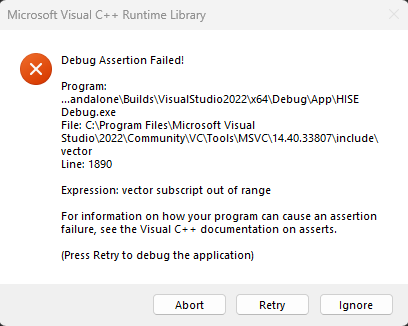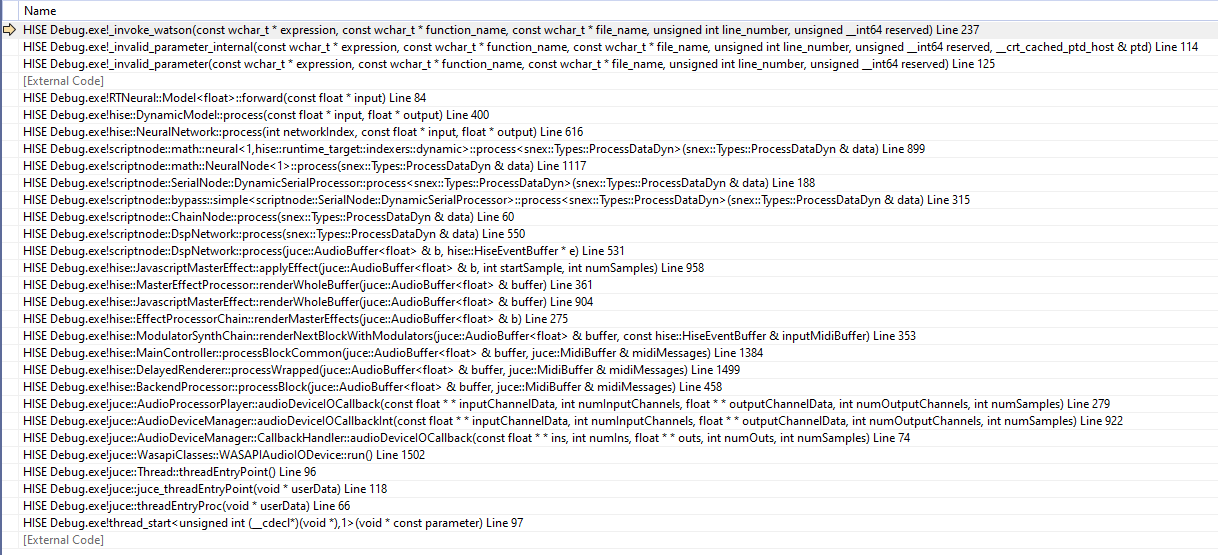Simple ML neural network
-
Trying to do a simple LSTM processor project. Where should one store their json files? Or do you paste in the weights directly? Using the ScriptNode Math function.
-
-
@Christoph-Hart ok got it. Let's say I wanted to cascade two different NNs
I'm guessing these parts will have to be modified somehow in order to differentiate between the networks. Would it just be a case of "obj1"
and "obj2"`// This contains the JSON data from `Scripts/Python/sine_model.json` const var obj = // load the sine wave approximator network nn.loadPytorchModel(obj);I'm pretty sure this is how you would set up the first part?
// We need to create & initialise the network via script, the scriptnode node will then reference // the existing network const var nn = Engine.createNeuralNetwork("NN1"); // We need to create & initialise the network via script, the scriptnode node will then reference // the existing network const var nn = Engine.createNeuralNetwork("NN2"); -
@Christoph-Hart so for now I decided to try and make a very simple audio processor using scriptnode. I followed the tutorial project adding the weights for the math.neural module to pickup, and it does see the object, however when I select it HISE crashes, complete CTD.
It's an LSTM network generated by a RTNeural based project (guitarML automatedguitarampmodelling pipline).
Not sure what the issue is.
-
Attached the model in case someone wants to look at it.
-
@ccbl Just did the same thing here. Used this script and it crashes HISE when I select the model:
https://github.com/GuitarML/Automated-GuitarAmpModelling
It's my first attempt, so I'm obviously doing something wrong. @Christoph-Hart is there a guide to train a model with audio files?
Also, is there a way to implement parameterized models? -
The Neural node is a promising feature.
It would be great to see an example guitar amp model (the most used case right now) with parameters.
-
@orange yeah actually being able to model amps would be magnificent. I have a project in the pipeline where it would save literal gigabytes (no need to deliver processed signals).
There was also talk in another thread, I think it was the Nam (Neural AMP modeller)
-
When I debug, I get failure here:


Is this caused by a key mismatch in the JSON?
@Christoph-Hart would you be able to take a quick look at this and see where it's muffed? -
@Dan-Korneff Sure I'll check if I find some time tomorrow, but I suspect there is a channel mismatch between how many channels you feed it and how many it expects.
-
@Christoph-Hart That would be awesome.
The json keys look like this:{"model_data": {"model": "SimpleRNN", "input_size": 1, "skip": 1, "output_size": 1, "unit_type": "LSTM", "num_layers": 1, "hidden_size": 40, "bias_fl": true}, "state_dict": {"rec.weight_ih_l0": -
@Christoph-Hart Don't wanna load you up with too many requests, but it would be super rad if we could get this model working in scriptnode.

-
@Dan-Korneff The model just doesn't load (and the crash is because there are no layers to process so it's a trivial out-of-bounds error.
Is it a torch or tensorflow model?
-
In the homepage: https://github.com/GuitarML/Automated-GuitarAmpModelling
It says:
Using this repository requires a python environment with the 'pytorch', 'scipy', 'tensorboard' and 'numpy' packages installed.
Regarding the Neural node, parameterized FX example such as Distortion or Saturation is required which is currently only Sinus synth example is available on the snippet browser.
-
@Christoph-Hart it should be a pytorch model.
This is the training script I'm testing with. It uses RTneural as a backend as well:
https://github.com/GuitarML/Automated-GuitarAmpModelling -
@Dan-Korneff Ah I see, I think the Pytorch loader in HISE expects the output from this script:
https://github.com/jatinchowdhury18/RTNeural/blob/main/python/model_utils.py
which seems to have a different formatting.
-
parameterized FX example such as Distortion or Saturation is required which is currently only Sinus synth example is available on the snippet browser.
The parameters need to be additional inputs to the neural network. So if you have stereo processing and 3 parameters, the network needs 5 inputs and 2 outputs. The neural network will then analyze how many channels it needs depending on the processing context and use the remaining inputs as parameters.
So far is the theory but yeah, it would be good to have a model that we can use to check if it actually works :) I'm a bit out of the loop when it comes to model creation, so let's hope we find a model that uses this structure and can be loaded into HISE.
-
@Christoph-Hart said in Simple ML neural network:
I'm a bit out of the loop when it comes to model creation, so let's hope we find a model that uses this structure and can be loaded into HISE.
That'll be my homework for the day. Thanks for taking a look.
-
I realise we already hashed this discussion out, and people might be sick of it. But IMO the NAM trainer has a really intuitive GUI trainer which allows for different sized networks, at various sample rates. It also has a very defined output model format, which seems to be a sticking point with RTNeural.
Given the existence of the core C++ library https://github.com/sdatkinson/NeuralAmpModelerCore
Might it be easier to implement this instead, given many people want to use ML Networks for non-linnear processing for the most part?
-
I'll just leave these here:
https://intro2ddsp.github.io/intro.html
https://github.com/aisynth/diffmoog
https://archives.ismir.net/ismir2021/paper/000053.pdf
https://csteinmetz1.github.io/tcn-audio-effects/
I'm convinced Parameter Inference and TCNs will be the future of audio plug-ins. CNN's will take over circuit modelling as the next fad. Training NN so we can map weights to params to make any sound source will take over. Just have a look at Synth Plant 2.
Having access to trained models from PyTorch in HISE would be awesome. A few VSTs devs are using ONNX Runtime in the cloud to store the weights and the VST calls back to perform the inferences.
P